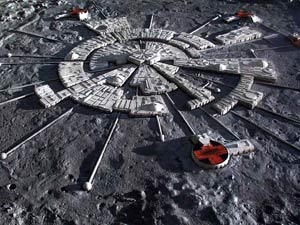Will mankind once again walk on the lunar surface? I wouldn’t even hesitate to say “yes”, because the future is long, and who in the early 1950s would have dared to predict that we would even land a craft on the Moon within 20 years? But in this case, the answer probably isn’t as interesting as the question itself – more specifically, when, and why, and how will we do it?
I can think of many possible scenarios that could lead to us colonising the Moon: an extended economic boom that allows us to fund ambitious space exploration; a breakthrough in launch costs which makes them drastically cheaper; or the discovery of some vital natural resource on the Moon. But I don’t like betting on breakthroughs.
A better question is then: “What is a likely way we’ll end up with a human presence on the Moon?” Given what we know today and extrapolating from there, I have a thought on how this could happen.
Looking into the abyss
Before we talk about settling down on our rocky neighbour, we have to ask why we should head there in the first place.
Looking back on nearly 60 years of space exploration, the answer is obvious. Satellite communication. Weather prediction. Understanding of climate change. Instantaneous broadcasting of radio and television. Global positioning technology. Detailed mapping of the Earth. Environmental monitoring. Government intelligence gathering (which has prevented far more conflict than people credit it for). Disaster warning.
And those are just concrete benefits from looking down from space. The advancement in technology from actually venturing out into space has paid for itself many times over, from computer tech and cell phone cameras (a direct descendent of technology developed for Hubble) to medical equipment such as infra-red ear thermometers and LED-based devices to treat muscle complaints.
So exploring space is not only a good idea, but has made real changes to life here on Earth. But we’ve been to the Moon before; six times, in fact. Haven’t we already been there and done that?
Far from it. Even Apollo 17, the longest of the missions, was only there for three days. The Moon has 38 million square kilometres of real estate, so we’ve literally only scratched the surface.
Floating convenience stores
Scientifically, the Moon is fascinating. While we’re pretty sure it coalesced from material blasted away from Earth after a massive impact billions of years ago, we don’t actually know. And with no atmosphere to erode its surface, it’s like a history book of the solar system.
Of course, going there is expensive – realistic estimates are about $US 35bn (27.9bn euros). Note that once there, humans can use local resources and save money in the long run. We know there’s lots of water ice on the Moon, and the rocks have oxygen locked up in them, so potentially there’s a way of creating water and air for future denizens. Quite a bit of work has already been done in this area, and its potential is bright. Other reasons to go – potential cheap energy from helium-3 mining, tourism, and the like – are too vague at the moment to count on.
So asking for that kind of money for only scientific research or exploration, even if it would eventually pay back several times the investment, would not be an easy sell. But there might be another reason to go, one that could swing the argument in its favour. And it involves something of a surprising and indirect stepping stone. Literally.
Circling the Sun between Mars and Jupiter are billions of asteroids, chunks of rock ranging in size from footballs to gigantic Ceres, 1,000 km (620 miles) across. Most of these are rocky, but even these have some amount of materials that are useful, including water ice, hydrogen, oxygen and even precious metals.



